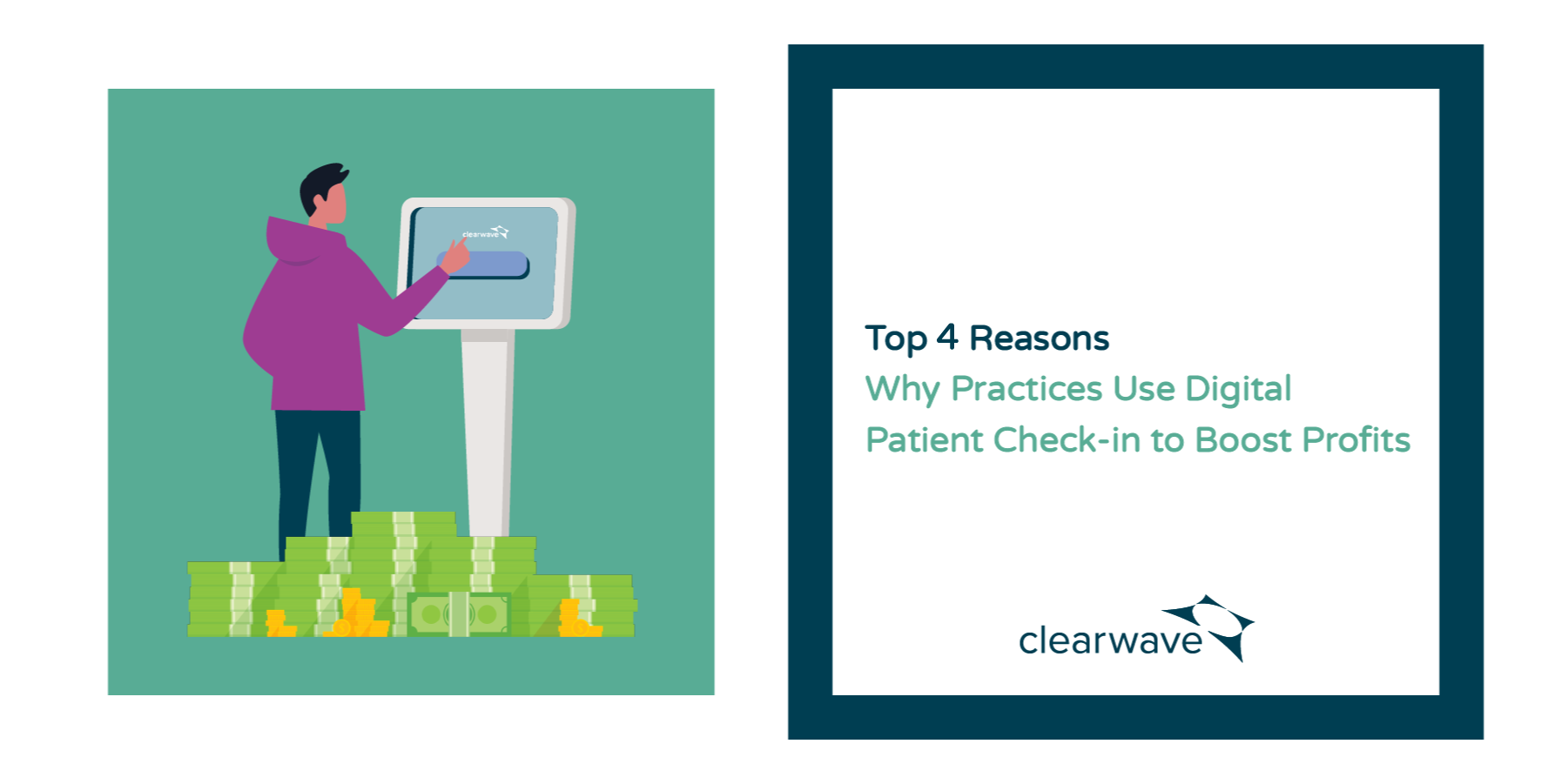Top 4 Ways Practices Use Digital Patient Check-in to Boost Profits

By Chloe From Clearwave | July 31, 2024
Digital patient check-in technology has revolutionized the way practices manage their front-office operations and increase revenue. By embracing digital patient check-in, practices can not only reduce administrative costs and create a seamless patient experience, but also drive key bottom-line impacts to profits. See the top five reasons why practices are turning to digital patient check-in to boost profitability!
1. Increase Collection Rates
One of the primary reasons practices implement digital patient check-in is to improve their collection rates. Traditional paper-based check-in processes often lead to missed opportunities for collecting patient payments, such as copays and outstanding balances. Additionally, slow insurance verification, even with automated solutions, can also impact your ability to determine accurate patient co-pays and collect them at check in. When payments are missed at the point-of-services, practices often have costly and time-consuming debt collection processes.
To circumvent these challenges, practices are prompting patients to pay co-pays and even past-due balances every time they check in. With digital patient check-in, practices can ensure that patients are prompted to settle their financial obligations before their appointment. By presenting patients with a convenient and secure platform to make payments, practices can significantly increase their point-of-service collections. To ensure they can collect accurate co-pays at every check-in with this approach, practices combine self-service check-in solutions with real-time, multi-factor eligibility verification.
Digital patient check-in solutions offer various payment options, including credit card processing, mobile payments and even payment plans. This flexibility caters to the preferences of different patient demographics, making it more likely for them to pay their bills on time. Practices that have implemented self-registration have seen immediate improvements to their co-pay and past-due balance collection rates. Ortho Florida’s care centers are a great example. These busy practices are driving average monthly co-pay collection rates of 95%. This high collection rate is a testament to the effectiveness of digital patient check-in, making it easier for patients to fulfill their financial obligations at the point of service.
2. Enhance Data Accuracy to Reduce Billing Costs
Accurate patient data is the foundation of efficient billing and effective care communication. However, manual data entry and paper-based forms often lead to errors and inconsistencies. Digital patient check-in addresses this challenge by empowering patients to update their own information, such as contact details, insurance information, and medical history. By allowing patients to input their data directly into the system, practices can ensure that the information captured is accurate and up-to-date.
Thomas Eye Group achieved a 94% reduction in claims rejections by implementing a comprehensive patient revenue platform offering digital patient check-in. The platform prompts patients to review and confirm or update their demographic and insurance information during the digital check-in process, leading to better data accuracy compared to traditional staff-led interactions. As a result of this improved data quality, practices like Thomas Eye Group experience fewer claim rejections, streamlining their revenue cycle management and boosting their bottom line. To elevate profits further, Thomas Eye Group used custom check-in questions to build interest and awareness for their premium services, resulting in a $400k increase in revenue, all while reducing their advertising spend.
Annapolis Neurology Associates are another great example of a busy practice that puts both patients and profits first. While caring for over 100 patients a day with diverse neurologic needs, the practice was able to drive a 100% drop in rejected claims caused by data errors. With digital patient check-in, the practice improved data accuracy, simply by enabling patients to review and update their information during check-in. Today the practice sees an 80% monthly co-pay collection rate and a 50% outstanding balance collection rate via kiosk.
Digital patient check-in solutions often incorporate data validation techniques, such as real-time, multi-factor eligibility™ verification. These features help your staff quickly identify and correct any discrepancies in patient information, reducing the chances of claim rejections and delays in reimbursement. Additionally, by having accurate patient data readily available, practices can streamline their billing processes, minimize administrative errors, and improve the overall efficiency of their revenue cycle management.
Learn more about mutli-factor eligibility verification and how it helps drastically drop staff workloads and outperform automated verification solutions they’ve used in the past. One CEO recently shared, “A multi-factor eligibility and benefits solution goes above and beyond what a practice’s PMS does. The amount of data and information that’s returned in Clearwave’s dashboard is much more comprehensive than a PMS.” Learn more about Ortho Florida’s experience with Clearwave here.
3. Drop Check-In Times to Boost Loyalty
Long wait times and cumbersome registration processes are common pain points for patients visiting healthcare practices. Digital patient check-in offers a solution to these challenges by streamlining the registration process and reducing wait times. With digital check-in, patients can complete their registration forms online before their appointment, either from the comfort of their homes or through a mobile device.
For example, United Skin Specialists saw a 150% drop in waiting room time after implementing digital patient check-in, while another practice, St. Cloud Orthopedics, reduced their average check-in time to one minute and sixteen seconds. Digital patient check-in eliminates the need for patients to arrive early and spend time filling out paperwork in the waiting room.
By providing a more convenient and efficient check-in experience, practices can significantly enhance patient satisfaction and loyalty. Improved patient loyalty, in turn, drives long-term patient value and profitability for the practice, as satisfied patients are more likely to return for future appointments and recommend the practice to others. This increased retention and word-of-mouth referrals contribute to the practice’s overall financial success.
4. Reduce Staff Workloads and Costs
Digital patient check-in has a profound impact on reducing staff workload and associated costs. Traditional check-in processes involve a significant amount of manual labor, such as data entry, document scanning, and payment processing. These tasks can be time-consuming and prone to errors, leading to inefficiencies and increased staffing requirements. By implementing digital patient check-in, practices can automate many of these repetitive tasks, freeing up staff time for more value-added activities. Although when you’re looking to truly reduce staff intervention in patient registration, it’s important to remember that not all digital/automated solutions are one in the same.
With proven digital patient check-in, practices can reduce the need for additional front-desk staff, even as they grow and expand their patient base. The automation of data entry and payment processing allows existing staff to handle a higher volume of patients without becoming overwhelmed. When staff members are not bogged down by mundane tasks, they can focus on providing exceptional patient care and contributing to the overall success of the practice.
Annapolis Neurology Associates experienced significant improvements in staff workload and efficiency after implementing digital patient check-in. The practice achieved a 60% reduction in required front-desk staff, demonstrating the power of automation in streamlining operations. Additionally, the practice saw a 32% drop in average check-in times, with patients completing the check-in process in just 2 minutes and 13 seconds on average. This efficiency not only benefited the patients but also allowed the staff to focus on more critical aspects of patient care.
Unlock the Power of Digital Patient Check-in
Digital patient check-in has emerged as a powerful tool for healthcare practices seeking to boost their profits. Practices that embrace proven digital patient check-in will be well-positioned to meet the changing expectations of patients and thrive in a competitive market.
If your practice hasn’t yet implemented digital patient check-in or isn’t seeing the results you aimed to with other digital solutions, now is the time to make a change. By partnering with Clearwave and integrating smart, digital check-in into your workflow, you can unlock the benefits of increased profitability, efficiency, and patient satisfaction. Embrace the power of digital patient check-in and take your practice to new heights of success, get in touch with the team at Clearwave for a demo today!
Recommended for you
Related Posts
How FQHCs Improve Revenue Management With Patient Kiosks
Reading Time: 3 minutesBy Blakely Roth | April 9, 2025 East Jordan Family Health Center (EJFHC) is a Federally Qualified Health Center (FQHC)…
Best Patient Check-In Software for Practices That Need to Reduce Costs
Reading Time: 5 minutesBy Chloe From Clearwave | April 8, 2025 Costs are on the rise, what are you doing now to combat…
Pros and Cons of Self-Service Kiosks in Healthcare
Reading Time: 6 minutesBy Chloe From Clearwave | March 24, 2025 Considering the pros and cons of self-service kiosks for your healthcare practice?…




